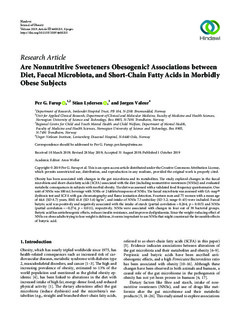| dc.contributor.author | Farup, Per Grønaas | |
| dc.contributor.author | Lydersen, Stian | |
| dc.contributor.author | Valeur, Jørgen | |
| dc.date.accessioned | 2020-02-11T09:08:10Z | |
| dc.date.available | 2020-02-11T09:08:10Z | |
| dc.date.created | 2019-10-01T20:28:34Z | |
| dc.date.issued | 2019 | |
| dc.identifier.citation | Journal of Obesity. 2019, 2019 1-8. | nb_NO |
| dc.identifier.issn | 2090-0708 | |
| dc.identifier.uri | http://hdl.handle.net/11250/2640931 | |
| dc.description.abstract | Obesity has been associated with changes in the gut microbiota and its metabolites. The study explored changes in the faecal microbiota and short-chain fatty acids (SCFA) associated with the diet (including nonnutritive sweeteners (NNSs)) and evaluated metabolic consequences in subjects with morbid obesity. The diet was assessed with a validated food frequency questionnaire. One unit of NNSs was 100 mL beverage with NNSs or 2 tablets/teaspoons of NNSs. The faecal microbiota was assessed with GA-map® dysbiosis test and SCFA with gas chromatography and flame ionisation detection. Fourteen men and 75 women with a mean age of 44.6 (SD 8.7) years, BMI 41.8 (SD 3.6) kg/m2, and intake of NNSs 7.5 units/day (SD 3.2; range 0-43) were included. Faecal butyric acid was positively and negatively associated with the intake of starch (partial correlation = 0.264; p=0.015) and NNSs (partial correlation = -0.274; p=0.011), respectively. NNSs were associated with changes in four out of 39 bacterial groups. Butyric acid has antiobesogenic effects, reduces insulin resistance, and improves dyslipidaemia. Since the weight-reducing effect of NNSs on obese adults trying to lose weight is dubious, it seems imprudent to use NNSs that might counteract the favourable effects of butyric acid. | nb_NO |
| dc.language.iso | eng | nb_NO |
| dc.publisher | Hindawi | nb_NO |
| dc.relation.uri | http://downloads.hindawi.com/journals/jobe/2019/4608315.pdf | |
| dc.rights | Navngivelse 4.0 Internasjonal | * |
| dc.rights.uri | http://creativecommons.org/licenses/by/4.0/deed.no | * |
| dc.title | Are Nonnutritive Sweeteners Obesogenic? Associations between Diet, Faecal Microbiota, and Short-Chain Fatty Acids in Morbidly Obese Subjects | nb_NO |
| dc.type | Journal article | nb_NO |
| dc.type | Peer reviewed | nb_NO |
| dc.description.version | publishedVersion | nb_NO |
| dc.source.pagenumber | 1-8 | nb_NO |
| dc.source.volume | 2019 | nb_NO |
| dc.source.journal | Journal of Obesity | nb_NO |
| dc.identifier.doi | 10.1155/2019/4608315 | |
| dc.identifier.cristin | 1732740 | |
| dc.description.localcode | Copyright© 2019 Per G. Farup et al. )is is an open access article distributed under the Creative Commons Attribution License,which permits unrestricted use, distribution, and reproduction in any medium, provided the original work is properly cite | nb_NO |
| cristin.unitcode | 194,65,15,0 | |
| cristin.unitcode | 194,65,35,5 | |
| cristin.unitname | Institutt for klinisk og molekylær medisin | |
| cristin.unitname | RKBU Midt-Norge - Regionalt kunnskapssenter for barn og unge - psykisk helse og barnevern | |
| cristin.ispublished | true | |
| cristin.fulltext | original | |
| cristin.qualitycode | 1 | |

